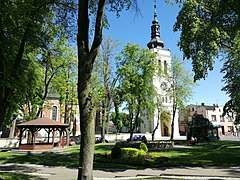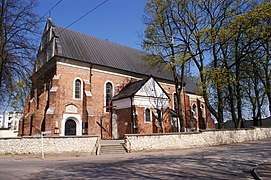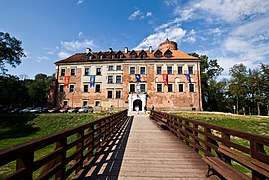Uniejów
Uniejów [uˈɲejuf] is a town in Poddębice County, Łódź Voivodeship, Poland, with 3011 inhabitants (2017).[1], the seat of the local government of Gmina Uniejów.
Uniejów | |
|---|---|
 | |
 Flag  Coat of arms | |
 Uniejów | |
| Coordinates: 51°58′12″N 18°48′1″E | |
| Country | |
| Voivodeship | Łódź |
| County | Poddębice |
| Gmina | Uniejów |
| Government | |
| • Mayor | Józef Kaczmarek |
| Area | |
| • Total | 12 km2 (5 sq mi) |
| Population (2017) | |
| • Total | 3,011 |
| • Density | 246/km2 (640/sq mi) |
| Time zone | UTC+1 (CET) |
| • Summer (DST) | UTC+2 (CEST) |
| Postal code | 99-210 |
| Car plates | EPD |
| Website | http://www.uniejow.pl |
The town lies in northwestern corner of Poddebice County, near the border with Wielkopolskie Voivodeship. Uniejów is famous for its Thermal Park and the 14th-century castle with a landscape park (34 hectares (84 acres)), regarded as one of the best preserved and most beautiful parks of central Poland.
History
The history of the town dates back to the early years of Polish statehood. Mentioned as Uneievo in a bull of Pope Innocent II (1136), Uniejów is one of the oldest towns of Poland. At that time it belonged to the Archbishops of Gniezno, and received its town charter most likely before 1290. In the late 13th century, Archbishop Jakub Swinka founded Church of the Holy Spirit, and in 1331, Uniejów was burned by the Teutonic Knights. The town was rebuilt, and in the late 14th - early 15th century, it was a local center of commerce and crafts. For centuries, Uniejów enjoyed several privileges, granted to it by the Archbishops of Gniezno. In 1360-1365, a defensive castle was built here. It became one of residences of the Archbishops, here several councils and meetings took place.
Like many Polish cities, Uniejów declined after Swedish invasion of Poland. The castle was ransacked, and the town itself was burned. There also were two dangerous fires, in 1736 and 1790, and after the Congress of Vienna (1815), the town became part of Russian-controlled Congress Poland, where it remained until World War One. In 1836, Uniejów was granted to a Tsarist General Aleksander Toll, and in 1870, it lost its town charter, becoming a village. In 1919 Uniejow again became a town.
In September 1939, during the Invasion of Poland, Polish units of Poznan Army resisted here the advancing Wehrmacht. During the heavy fighting, Uniejów was partially burned.
Currently, Uniejów is a popular spa and tourist destination, due to its landscape park and geothermal waters. The town has several restaurants, hotel located in the castle, and other amenities. There also are walking and bicycle trails. Among sights are Gothic castle (built in 1360-1365 by Archbishop Jaroslaw of Bogoria and Skotnik, restored in 1956-67), collegiate with a 14th-century Gothic presbytery, neo-Baroque church tower (1901), Classicistic manor house (1845). The village of Spycimierz, with its ancient Slavic gord, lies four kilometres (2.5 miles) away.
Thermal spa
Geothermal water exploited by Uniejów Municipality [2] has been used in balneotherapy since the 1990s. Positive opinions of people using the thermal bath, the natural and landscape potential of the Municipality, its tourist and recreational values prompted the local authorities to apply for the status of a health resort. The milestones [3]:
- In 2008 the National Institute of Public Health -National Institute of Hygiene issued a certificate on the healing properties of water from the PIG / AGH-2 spring.
- In the same year, a certificate was issued confirming the healing properties of the Uniejów climate together with an assessment of bioclimatic conditions, as well as a climatic survey, developed by Stanisław Leszczycki Institute of Geography and Spatial Management – Polish Academy of Sciences in Warsaw [4] .
- Based on these documents in 2011, a positive opinion for Uniejów resort was issued - the main document of the spa resort.
- In the same year, the Minister of Health issued a decision confirming the possibility of spa treatment in the Municipality of Uniejów. The following diseases can be treated here: orthopedic and traumatic, nervous, rheumatological, peripheral nervous system, skin.
- In 2012, the Prime Minister signed a regulation on granting the status of a health resort to the town of Uniejów together with the villages of: Spycimierz, Spycimierz-Kolonia, Zieleń and Człopy.
Due to the fact that the basis for spa treatment in Uniejów is geothermal water, the town of Uniejów has been given the status of a "thermal spa".
Places of interest
- Uniejów Castle and castle park: the castle tower, the yard and the underground room are opened to visitors. Guided tours are available. The tower is accessible from April to the end of November. The visitors can take a walk through the 19th century English landscape garden with various nature monuments.
- The 14th-century collegiate church located near the market square. The elements that are of the greatest historic importance include the 14th-century cross-ribbed vaulting, and the bronze sarcophagus, dating back to 1666, of St. Bogumił. The chapel and the sarcophagus have been renovated recently. The archbishop’s relics are still kept in the collegiate. Near the church there is the 25-metre-high neo-Baroque bell tower.
- Uniejów Thermal Park [5]: consists of a number of both outdoor and indoor thermal pools. The water temperature is 33°C in summer and 35°C in winter. The buildings are entirely heated with geo-thermal energy [6]. Being the combination of both – a modern thermal spa resort and traditional aquapark – it is a perfect place for families. Uniejów Thermal Park was awarded in the prestigious “The Seven Wonders of Poland” competition which has been organized by the National Geographic Traveler (Polish edition). It is open to visitors 365 days in a year.
Gallery
 The market square, the collegiate church and the bell tower
The market square, the collegiate church and the bell tower 14th-century Collegiate church
14th-century Collegiate church 14th century Castle of the Archbishops of Gniezno
14th century Castle of the Archbishops of Gniezno Uniejów Thermal Park
Uniejów Thermal Park
References
- Population, vital statistics and migration in the Lodzkie Voivodship in 2017, as of December 31. Lodz: Statistical Office in Lodz. 2018. p. TABL. 1.
- " Geothermal power in Gmina Uniejów" https://en.wikipedia.org/wiki/Gmina_Uniej%C3%B3w
- " First Thermal Spa (in Polish)"https://uniejow.pl/o-gminie/pierwsze-uzdrowisko-termalne.html
- " Stanisław Leszczycki Institute of Geography and Spatial Management " https://www.igipz.pan.pl/home_en.html
- http://uniejow.gotopoland.eu/tourism-travel-to-poland/uniejows-attractions/uniejow-thermal-park-and-spa-in-poland.html
- "The use of geothermal power in Uniejów" (Wikipedia) https://en.wikipedia.org/w/index.php?search=Gmina%20Uniej%C3%B3w&title=Special%3ASearch&fulltext=1
External links
| Wikimedia Commons has media related to Uniejów. |